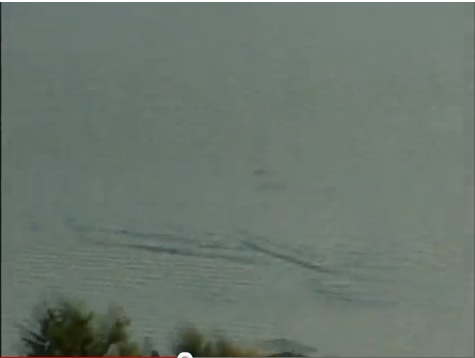Was the 'Canadian Loch Ness Monster' Caught on Video?

A man visiting British Columbia's Lake Okanagan last week claims to have captured video of Ogopogo, Canada's version of the Loch Ness Monster.
According to a report in the Vancouver Sun, "An Okanagan man has video he says proves the Ogopogo may be more than just a figment of our imagination. Richard Huls says he always believed in the possibility of the monster rumored to be living in Okanagan Lake. Last Thursday, while visiting a West Kelowna winery, Huls shot video that he believes proves something does indeed live in the water. 'It was not going with the waves,' Huls said. 'It was not a wave obviously, just a darker color. The size and the fact that they were not parallel with the waves made me think it had to be something else."
Ogopogo, some believe, has its roots in native Canadian Indian legends that told of a beast called N'ha-a-itk that would demand a live sacrifice from travelers for safe passage across Lake Okanagan. Hundreds of years ago, whenever Indians would venture into the lake, they brought chickens or other small animals to kill and drop into the water to assure a protected journey. It's clear, however, that these stories were not referring to a literal lake monster but instead to a legendary water spirit, and are not historical evidence for Ogopogo. [Mythical Creatures That Don't Exist (or Do They?)]
The lake has been searched before. A 1991 expedition financed by Japan's Nippon Television looked for the monster with high-tech devices, including a remotely-operated vehicle and a miniature submarine. The pilot took the vehicle to a depth of 840 feet along the lake bottom at the deepest part of the lake, but no Ogopogos were sighted, nor did the submarine discover any of the creatures' carcasses or bones. There remains no hard evidence of the monster, which is said to have a series of humps and a head resembling a snake, horse, or bulldog. In fact a great many sightings simply report a straight, featureless "log" that seemed to be floating in the waves.
The best film evidence of Ogopogo is about a minute of footage shot in 1968 by a man named Arthur Folden. On a sunny day in August of that year, Folden noticed "something large and lifelike" out on the calm water. Folden, a home movie buff, pulled out his camera and captured the object in the water. The film begins with a noticeable disturbance in the water. The object begins moving to the right of the screen and picks up speed as it swims, creating a noticeable wake.
I was asked by National Geographic to participate in an expedition searching for Ogopogo in 2005, and to evaluate Folden's film. Through scientific experiments, we concluded that the object Folden filmed was in fact a real animal (and not a wave or floating log), but its size had been greatly overestimated. It was probably a water fowl or beaver that was too far away to be properly identified. The new video of Ogopogo by Huls seems to be very similar in that regard.
So what exactly did Huls record? The video quality is poor, and the camera is shaky, so it's hard to tell what the object is, or even if it's moving. But a closer look at the 30-second video reveals that, instead of one long object, there are actually two shorter ones, and they seem to be floating next to each other at slightly different angles. There are no humps, nor head, nor form; only two long, darkish, more or less straight forms that appear to be a few dozen feet long. Perhaps not coincidentally, Lake Okanagan has tens of thousands of logs harvested by the timber industry harvested floating just under the lake's surface.
Get the world’s most fascinating discoveries delivered straight to your inbox.
This story was provided by Life's Little Mysteries, a sister site to LiveScience. Follow Life's Little Mysteries on Twitter @llmysteries, then join us on Facebook.
Benjamin Radford is deputy editor of Skeptical Inquirer science magazine and author of Scientific Paranormal Investigation: How to Solve Unexplained Mysteries. His Web site is www.BenjaminRadford.com.



